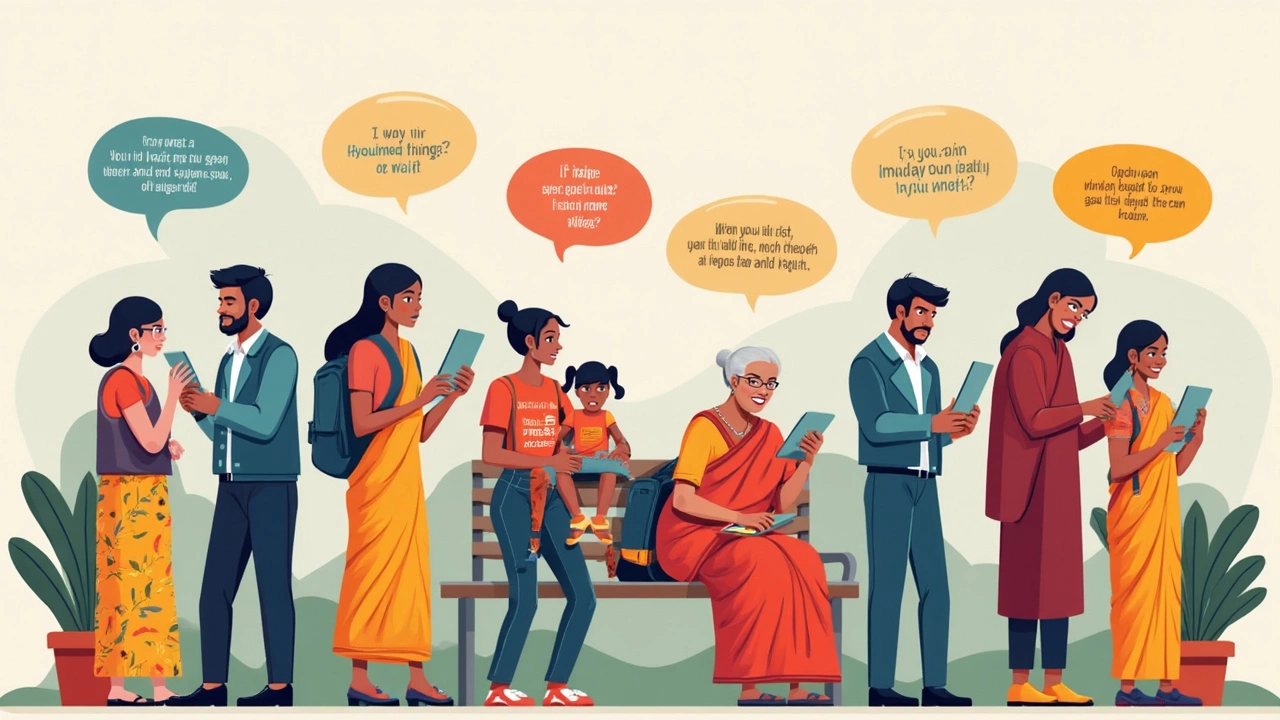Ever found yourself wishing you could just grab your phone and chat your way to better English? You're not alone. These days, there are free apps designed exactly for that. Instead of sitting through endless grammar videos, you can start speaking real English with people from around the world—sometimes without paying a cent.
The trick is knowing which app actually helps you speak more, instead of just memorizing words or tapping pictures. Apps like Duolingo, HelloTalk, and Cake have made talking in English accessible, even if you don’t have money to spend on classes. Some even connect you with native speakers, letting you ask, “How’s my accent?” or “Did I say this right?” and get actual feedback.
If you feel stuck practicing by yourself or can never remember what you learned, these apps keep things simple: short lessons, fast progress, and a real chance to build your confidence talking out loud. No need to wait for perfect grammar—just tap, speak, and surprise yourself with how quickly you learn. Ready to find out which app matches your style?
- Why Free Apps Work for English Speaking
- Top Free Apps Everyone Is Using
- Features That Actually Help You Speak
- Tips for Fast Progress with Free Apps
- Common Pitfalls and How to Avoid Them
Why Free Apps Work for English Speaking
Free English speaking apps have changed the game for people trying to learn English on a budget. First, almost everyone owns a smartphone, so access is easy—there’s no driving to a class or paying for tutors upfront. The apps are set up for quick use, which fits everyday life. You just need a few free minutes to squeeze in some practice, whether you’re waiting in line or sitting on the bus.
One big reason these apps work: they copy real conversations. Instead of weird textbook phrases, most of them use common topics, slang, and questions you’ll actually use. This means you’re practicing exactly what you need for real life, not outdated sentences you’ll never say.
And let’s talk about feedback. Many apps let you record your voice, compare it to a model, or chat with real people who give you pointers. That’s the kind of practice that helps you figure out if your message is clear—not just if your grammar is perfect. According to a survey by Statista, more than 58% of language learners use mobile apps as their main way to practice speaking in 2024. This isn’t just a trend—it's become the go-to method for busy adults and teens alike.
- You get exposure to different accents and real-world vocabulary.
- Gamified lessons keep you motivated with points or streaks.
- Built-in reminders help you stay consistent.
- Social features let you practice with actual people, not just computers.
Take a look at how popular these apps have become in just five years:
| Year | People using language learning apps worldwide (millions) |
|---|---|
| 2020 | 350 |
| 2021 | 400 |
| 2022 | 500 |
| 2023 | 560 |
| 2024 | 600 |
The best part? If you stick with it, free apps can actually turn language learning from a chore into a daily habit. Using a free English speaking app won’t magically make you fluent overnight, but it does make practice super easy—no more excuses.
Top Free Apps Everyone Is Using
Everyone seems to have a favorite app for learning English, but a few free ones keep coming up over and over. If you're aiming for real speaking skills, these aren’t just downloads—they’re actually what people use every day to get better at conversations, pronunciation, and confidence.
Let’s look at some top picks, why they work, and what makes them stand out:
- HelloTalk: This app lets you chat with native English speakers in real time. You can text, use voice messages, or even hop on free calls. The best part? People help each other with corrections—so you’re not just talking, you’re getting real feedback.
- Duolingo: It’s famous for a reason. While people think it’s just about vocab drills, Duolingo now includes speaking lessons where you repeat and answer in English. Daily reminders push you to practice a little every day, making it hard to quit or forget.
- Cambly (Free Minutes): Cambly is usually paid, but they give away free minutes—enough to try talking with real tutors. Sometimes, just one conversation makes a huge difference. It’s a chance to experience real conversations without paying upfront.
- Cake: Here, you practice short, real English phrases from videos and even record yourself speaking. Cake uses video clips from movies and YouTube, so you hear and try everyday English, not textbook examples.
- Speaky: Similar to HelloTalk, it matches you with English learners or native speakers for voice or text chats. It’s simple, not bloated with extras, so you can get straight to talking.
Curious how these apps stack up? Here’s a quick table with features that matter for those chasing English fluency:
| App Name | Speaking Practice | Native Speaker Access | Free Features | Average User Rating |
|---|---|---|---|---|
| HelloTalk | Yes (Text, Voice, Calls) | Yes | All core chat features | 4.5/5 |
| Duolingo | Yes (Voice lessons) | No | Full daily lessons | 4.7/5 |
| Cambly | Yes (Live Tutors) | Yes | Free trial minutes | 4.4/5 |
| Cake | Yes (Record & Playback) | No | Video lessons, quizzes | 4.6/5 |
| Speaky | Yes (Voice & Text) | Yes | Language exchange | 4.3/5 |
It’s worth remembering that a free English speaking app only works if you use it often. Make it part of your day—like checking messages or scrolling through social media—and you’ll see real progress. If you’re shy, start with recorded voice messages, then move to live chats when you’re ready. Don’t just download and forget. The results depend on how often you open the app and actually speak.

Features That Actually Help You Speak
Not every language app gives you the tools to really speak English out loud. The best ones push you to use your voice, not just your thumbs. This is the key difference if you’re serious about speaking, not just reading or listening. Want to know what really makes a free English speaking app work?
- Speech Recognition: Most leading apps (think Duolingo, Cake, or Elsa Speak) listen to your pronunciation and tell you straight away if you sound right. Elsa, for example, goes deep: it rates your accent on single words, whole sentences, and gives feedback you can act on instantly.
- Conversation Simulations: Apps like Busuu and Cake set up back-and-forth chats with virtual characters or even other learners. This makes it easy to practice saying things you’d actually use in real life, like ordering food or making small talk.
- Real Human Interaction: HelloTalk shines here. It matches you with real people, often native speakers, to exchange voice notes or even have short live calls. You can ask for corrections and get real feedback on the spot—to help you sound natural instead of textbook.
- Daily Speaking Challenges: Some apps pop up every day with quick speaking prompts (“Describe what you see in your room” or “Talk about your favorite movie”). They don’t care if it’s perfect—just that you practice.
- Instant Translations and Corrections: The better apps show your mistakes right away and give you the correct version. This way, you actually stop repeating errors instead of guessing or hoping for the best.
Don’t sleep on these features. They turn learning from something passive to something active—forcing you to speak, mess up, and then get better. The fancy stuff like chatbots or in-app calls isn’t just for show—they’re what make real progress possible.
Tips for Fast Progress with Free Apps
If you want to get good at English fast with free apps, you need to be smart about how you use them. Here are some real tips people actually use for faster results, not just common advice you’ll hear everywhere.
- Practice out loud every day. Reading silently or listening is fine, but talking is what really helps. Say the answers, repeat after the app, or pretend you’re having a real conversation—even if you’re alone.
- Mix up your skills. Don't just do vocabulary drills or listen to dialogues. Try all the game modes: speaking, listening, and real-time chats. Duolingo, for example, has a speaking exercise in almost every lesson, but you’ve got to actually tap the mic and talk. Don’t skip it, even if you feel a bit silly.
- Find a speaking buddy. Apps like HelloTalk and Tandem let you connect with real people. Set a tiny goal: chat with someone for five minutes a day. Short, real conversations help like nothing else.
- Use review features. Most apps track your mistakes and remind you to practice weak words or tricky grammar. Don’t ignore those reminders—the review cycle is how your brain locks in the language. On Cake, the review pop-ups are gold, especially for fixing pronunciation.
- Turn notifications on, at least at first. These little nudges help you remember to practice—even during a busy week.
Here’s a quick look at how much time learners typically spend on these apps before seeing solid improvement:
| App | Average Daily Use | Fluency Progress Noticed |
|---|---|---|
| Duolingo | 15 minutes | 2-3 months |
| HelloTalk | 10-20 minutes | 4 weeks |
| Cake | 10 minutes | 5-8 weeks |
The most important thing—no matter which free English speaking app you’re using—is staying consistent. Even five minutes daily beats one long session once a week. Make it a part of your routine, maybe right after breakfast or before bed, and you’ll start to see yourself getting quicker and more comfortable every time you speak.

Common Pitfalls and How to Avoid Them
A free English speaking app can feel like your new best friend—until you hit some roadblocks. It happens to almost everyone: you get stuck, bored, or stop improving. So, what trips most people up when using these apps, and how do you stay ahead?
free English speaking app users often make the same simple mistakes. One huge pitfall is treating the app like a game and just racing through levels, barely speaking aloud. Sure, your phone says you completed level 10, but can you order food in English without freezing up? Probably not yet. Real progress comes from actually talking, not just tapping.
Another common issue is neglecting feedback. Most good apps, like HelloTalk, let you connect with native speakers or get corrections on your messages. If you skip this and never check your mistakes, you’ll keep repeating them. As Benny Lewis, author of "Fluent in 3 Months," puts it:
“If you’re not getting corrected, you’re not really learning. Don’t be afraid of mistakes, but make sure you learn from them.”
Sticking to only one app is another trap. Each app has its strengths; Duolingo is quick and playful, but HelloTalk or Tandem give you the real conversations that push you further. Mixing them up keeps things interesting and covers your weak spots.
Here’s a quick table sharing the most reported pitfalls and simple fixes:
| Pitfall | Simple Fix |
|---|---|
| Only typing, not speaking | Read answers out loud, use voice-chat features |
| Ignoring feedback | Send questions/messages to native speakers, and review their corrections |
| Sticking with beginner lessons | Push to higher levels or switch to conversation-based tasks |
| Losing motivation after a week | Set mini-goals, like practicing with a buddy or recording yourself daily |
Here’s something a lot of people miss: a British Council survey found that learners who practiced English for just 10 minutes a day using an app and made a habit of speaking saw a 30% faster improvement in confidence and fluency than those who just did exercises in silence.
If you want real results, make your practice active, grab feedback, and switch things up when you’re bored. Treat the app as your speaking partner, not just a timer. That’s how you move past where most people get stuck—and actually start talking like a local.





